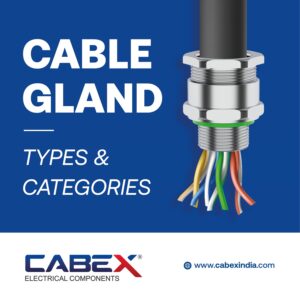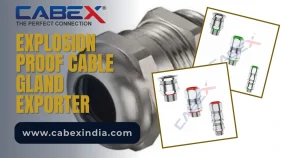Why Brass Cable Glands Are Critical for Industrial Safety
Brass cable glands are the unsung workhorses of industrial, electrical, and construction sectors spanning India, the Middle East, and Europe. When installed correctly, they protect workers and assets from catastrophic fires, explosions, and costly operational downtime. In hazardous industries, choosing the right cable gland isn’t a luxury—it’s a regulatory and safety requirement.
Leveraging semantic relationships, here are the key entities in the cable gland vertical:
- Brass cable gland — Main entity for industrial sealing and termination.
- Explosion-proof cable glands — Fire and spark containment for high-risk zones.
- Explosion brass cable glands — Combines material durability with explosion protection.
- Earthing accessories — Reliable earth continuity and safety in installations.
- Industrial cable connectors — Secure electrical connections with certified performance.
- ATEX, IECEx, ISI certifications — Compliance marks for hazardous area installations.
B2B Market & Industry Trends, 2025 Data
Market Growth & Demand
- Global cable glands market (2024): $1.97B, projected growth to $3.13B by 2033 at 5% CAGR.
- Middle East cable glands (2024): $40.3M, 6.2% CAGR through 2031.
- India Infrastructure: $128.64B budget allocation (2025-26), 2.9% IIP growth, rapid expansion in power, construction, and EV sectors.
- Europe: Industry 4.0, EV boom (22.7% of new cars in 2023), 35% growth in EV charging stations (2024).
This surge creates mounting demand for reliable, compliant brass cable glands—especially ATEX- and IECEx-certified models for hazardous environments.
Hazardous Area Compliance
- ATEX (EU): Legally required in the European Economic Area for explosive atmospheres.
- IECEx (Global): Accepted in 50+ countries (India, Australia, Saudi Arabia), increasingly a de facto international standard.
- ISI/CMRI (India): Local compliance for hazardous installations.
Stat: Over 70% of fire incidents in refineries and chemical units are linked to improper cable termination or sub-standard accessories.
Real User Pain Points & Industry Questions (Reddit, Quora, Forums)
Citing actual purchaser challenges:
- Explosion-proof authenticity: “How do I know if my cable gland is truly explosion-proof? The Chinese stuff is everywhere but seems untested.” – Reddit, r/ElectricalEngineering
- Lack of documentation: “We received cable glands for ATEX panels, but documentation was missing. Is that a risk for inspection?” – Quora (ATEX Certification – Electrical)
- Design compatibility: “My site has both armoured and unarmoured cables. Can I use the same gland design for both?” – Reddit, r/Electricians
- IP Ratings confusion: “IP68 sounds impressive, but does it actually protect against constant water exposure in humid plants?” – Quora (IP Ratings for Cable Gland)
- Replacement cycles: “How often should cable glands be replaced or checked for wear in petrochemical installations?” – Reddit, r/AskEngineers
- Mechanical reliability: “How to prevent cable glands from eventually loosening and rotating in vibration-prone environments?” – Reddit, r/AskEngineers
- Fit and sealing: “The compression ring won’t seal properly, leading to water ingress. Do I apply tape, or am I missing a trick?” – ElectriciansForum UK
Actionable Advice for Addressing Pain Points
- Demand and verify ATEX/IECEx/ISI marks on both gland and packaging—avoid uncertified hardware.
- Request complete technical datasheets and batch traceability for every shipment.
- For armoured cable, use double-compression Brass cable glands with armor clamps.
- IP68 rating means dust-tight and continuous water immersion protection. Check for robust sealing gaskets, especially for chemical and humid environments.
- Implement annual maintenance audits (visual and torque checks), replace corroded or pitted glands, and keep logbooks of certification numbers.
- Use proper mechanical locking (loctite, lock nuts, or flats) in vibration-prone areas; avoid thread lock compounds on plastics.
- Avoid fit errors by matching gland and cable diameters, referencing manufacturer size charts.
Expert Quotes
“Electrical accidents claim more than 5,000 lives annually. And productivity losses from disruptive power can pull down revenues by 5–10%. These are not mere numbers; they represent the human and economic cost of safety lapses.”
— Harish Bhardwaj, National Head, Industry Vertical at Polycab“Technology transfers and strategic acquisitions are crucial to India’s self-reliance in high-end electronics manufacturing. Partnerships provide access to specialised expertise, streamline supply chains, and facilitate quicker market entry.”
— Josh Foulger, President (Electronics), Zetwerk
“About 99% of the mobile phones being used in India are being manufactured domestically… the value addition taking place in India is about 15% to 20%… Going forward, we intend to… take it up to 35% to 40%.”
— S. Krishnan, Secretary, Ministry of Electronics and IT (MeitY)
Types of Brass Cable Glands & Related Accessories
| Type | Description | Typical Application |
| Flameproof (Ex d, Ex e) Brass Glands | Prevent spark/flame propagation, ATEX/IECEx certified | Oil & gas, refineries, chemicals |
| Industrial Non-flameproof Glands | General cable management | Panels, buildings, non-hazard zones |
| Weatherproof/Waterproof Brass Glands | IP66–IP68 ingress protection (water, dust) | Utilities, construction, outdoor |
| EMC/Armoured Brass Glands | EMI shielding, mechanical durability | Manufacturing, power plants |
| Earthing Accessories | Safe electrical continuity dissipates fault current | All industrial/utility installations |
| Lightning Protection Connectors | Diversion of surge energy, system safety | Industrial rooftops, substations |
Certification Requirements: ATEX, IECEx, ISI
ATEX Certification (EU)
- Mandatory in Europe for explosive atmospheres.
- Ex-marked cable glands (Ex d, Ex e).
- Requires notified body assessment for high-risk. Self-certification may work for low-risk (Category 3).
IECEx Certification (Global)
- International, covers 50+ countries.
- Annual audits and testing for ongoing compliance.
- Growing adoption in Middle East, Asia, and Africa.
ISI/CMRI Certification (India)
- Domestic safety compliance in hazardous zones.
Tip: For cross-border B2B procurement, dual ATEX/IECEx certification with batch traceability is ideal.
Installation & Maintenance Best Practices
Installation:
- Tighten gland to manufacturer-specified torque.
- Seals should show manual resistance—not deformation.
- Use matching brass/stainless nuts for earthing.
- Ensure armor clamp is properly fixed for armoured cables.
Maintenance:
- Annual torque and visual checks in hazardous zones.
- Replace if corroded, pitted, or if insulation breaks down.
- Log and track ATEX/IECEx batch numbers for audits.
B2B Procurement Checklist
- Are all glands certified (ATEX/IECEx/ISI) and batch-traceable?
- Has supplier provided datasheets and test reports?
- Are glands compatible with cable type and enclosure material?
- Is there clear installation and maintenance documentation?
- Are earthing and insulation standards (IEC 60079-0/-1/-7) met?
How to Choose the Right Brass Cable Gland
Deciding on the perfect cable gland for your application involves assessing several parameters:
- Hazardous Zone Classification:
- Zone 1 & 2: Flammable gas/vapor
- Zone 21 & 22: Flammable dust
- Use site DCS and safety plans.
- Cable Construction:
- Armoured: Requires an armor clamp, double-compression gland.
- Unarmoured: Standard single-compression gland.
- Certification Compliance:
- Only select glands with valid ATEX/IECEx/ISI marks. Request technical datasheets and batch records.
- Ingress Protection (IP) Rating:
- For harsh/wet/chemical areas, opt for IP68-rated glands.
- Material Choice:
- Brass for conductivity and durability. Use stainless steel in corrosive/aggressive environments.
- Accessories Needed:
- Specify locknuts, shrouds, earthing tags, reducers, and adaptors as per cable and enclosure.
Conclusion
In hazardous and industrial environments, Brass cable glands that are ATEX and IECEx certified are critical for safety, compliance, and reliability. B2B buyers in India, the Middle East, and Europe should prioritize traceability, documentation, and alignment with entity-level standards, not just price. Effective installation and regular maintenance underpin long-term operational safety and business continuity.
(FAQ)
Q: What is a flameproof cable gland?
A: It’s a device designed to stop sparks or flames from getting out of electrical enclosures. It protects workers and the facility by keeping explosions and fires at bay in hazardous zones.
Q: Which cable gland is best for oil refineries in India?
A: Use ATEX-certified, flameproof brass cable glands with IP68 rating and batch traceability—these meet the strictest safety and compliance standards.
Q: How do I know if a cable gland is explosion-proof?
A: Look for ATEX or IECEx marks on the product and its packaging. Always ask for supporting documentation, such as certification documents and datasheets.
Q: Can one gland type work for both armoured and unarmoured cables?
A: No—armoured cables need glands with armor clamps (double-compression), while unarmoured cables require single-compression glands. Always specify the type of cable when ordering.
Q: Does IP68 mean my cable gland is fully waterproof?
A: Yes. IP68 rating means the gland is dust-tight and can withstand long-term immersion in water—ideal for outdoor or humid locations.
Q: How often should I inspect or replace cable glands?
A: For hazardous areas, inspect all cable glands visually and with a torque check every year. Replace any showing corrosion, wear, or compromised insulation. Keep a log of certification batch numbers for compliance.
Q: What’s the risk in using uncertified cable glands in my project?
A: Uncertified glands threaten people’s safety, can cause fires or explosions, and will fail regulatory audits—leading to project shutdowns and liability.
Q: Why choose brass over plastic or steel?
A: Brass offers superior conductivity, corrosion resistance, and long-term durability. Steel is best for aggressive chemicals or high vibration, while plastic suits lighter duties.
Q: What documentation should my supplier provide?
A: Always ask for technical datasheets, ATEX/IECEx certificates, and batch codes for traceability. For installations, request step-by-step guides and inspection checklists.
Q: Can one size gland fit all cable types?
A: No. Use manufacturer sizing charts—measure both the cable diameter and insulation thickness. Never force a fit; poor installation can cause leaks or safety failures.
You May Also Like: Top Questions Cable Accessories , Buy Explosion Proof Cable Glands Online






